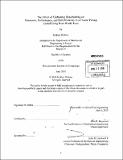The effect of carburetor refurbishing on emissions, performance, and fuel economy in a classic pickup tested using real-world tests
Author(s)
Holmes, Jacklyn (Jacklyn A.)
DownloadFull printable version (6.184Mb)
Other Contributors
Massachusetts Institute of Technology. Dept. of Mechanical Engineering.
Advisor
John B. Heywood.
Terms of use
Metadata
Show full item recordAbstract
This project investigated how refurbishing the carburetor of a 1952 Chevrolet Pickup would affect emissions, performance, and fuel economy. The test used were real-world tests that anyone, with or without access to a laboratory, can perform. The design of the real-world tests is important for ascertaining good results. Thought should go into how to perform the tests safely while still eliminating as many variables as possible. The emissions at idle improved by reducing the carbon monoxide percentage from 4-6% to 2- 3%. The hydrocarbon levels were reduced from 800-1000 ppm to 500-600 ppm. The results of the emissions test were unclear at cruise. The performance data showed that the vehicle had a slower acceleration after the refurbishing. The time to go from stopped to 100 feet in first gear was 5.46 s before refurbishing, and 6.48 s after refurbishing. It is possible that the vehicle was running lean at wide-open throttle after refurbishing. The fuel economy improved with the refurbished carburetor. The initial fuel economy was 10.7 mpg and the final fuel economy was 15.2 mpg. Once the results from the tests are collected, they need to be scrutinized to see if they are plausible using empirical data. Even with extreme care it is difficult to get precise measurements using real-world tests. The emissions data at cruise was not consistent with idle and could not be used. The fuel economy tests and emissions tests at idle show that the engine was running less fuel rich after refurbishing.
Description
Thesis (S.B.)--Massachusetts Institute of Technology, Dept. of Mechanical Engineering, 2010. Cataloged from PDF version of thesis. Includes bibliographical references (p. 28).
Date issued
2010Department
Massachusetts Institute of Technology. Department of Mechanical EngineeringPublisher
Massachusetts Institute of Technology
Keywords
Mechanical Engineering.